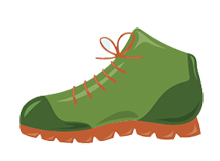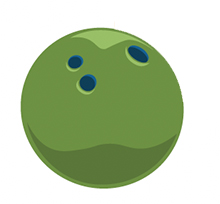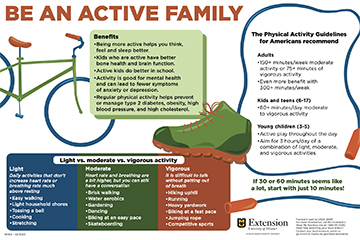New
Editor’s note
The following abstract describes a publication that is available as a downloadable PDF.
See the companion publication N1055, Be An Active Family handout.
This poster addresses the importance of being physically active, reviews guidelines for physical activity for families and provides tips for ways to be more physically active and less sedentary.
Topics
- Physical activity
- Physical activity for families
- Exercise
- Health
- Lifestyle activity
- Aerobic
- Muscle strengthening
- Sedentary
- Inactivity
- SNAP
Pages
- One 36 x 24 inches poster
See poster content below.
Be an Active Family
Benefits
- Being more active helps you think, feel and sleep better.
- Kids who are active have better bone health and brain function.
- Active kids do better in school.
- Activity is good for mental health and can lead to fewer symptoms of anxiety or depression.
- Regular physical activity helps prevent or manage type 2 diabetes, obesity, high blood pressure and high cholesterol.
The Physical Activity Guidelines for Americans recommend
Adults
- 150+ minutes/week moderate activity or 75+ minutes of vigorous activity
- Even more benefit with 300+ minutes/week
Kids and teens (6–17)
- 60+ minutes/day moderate to vigorous activity
Young children (3–5)
- Active play throughout the day
- Aim for 3 hours/day of a combination of light, moderate and vigorous activities.
Light vs. moderate vs. vigorous activity

Light
Daily activities that don’t increase heart rate or breathing rate much above resting
- Easy walking
- Light household chores
- Tossing a ball
- Cooking
- Stretching
Moderate

Heart rate and breathing are a bit higher, but you can still have a conversation.
- Brisk walking
- Water aerobics
- Gardening
- Dancing
- Biking at an easy pace
- Skateboarding
Vigorous
It is difficult to talk without getting out of breath.
- Hiking uphill
- Running
- Heavy yardwork
- Biking at a fast pace
- Jumping rope
- Competitive sports
